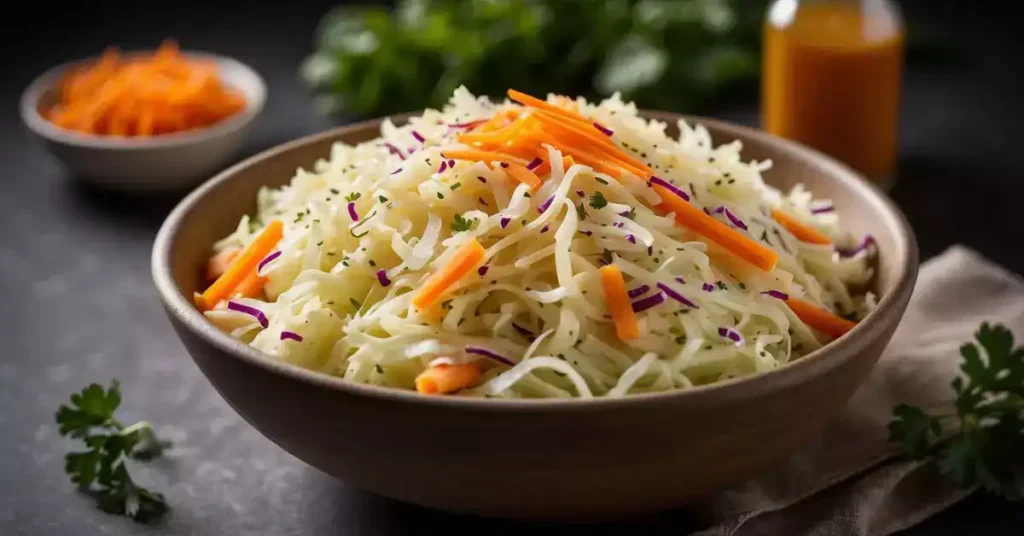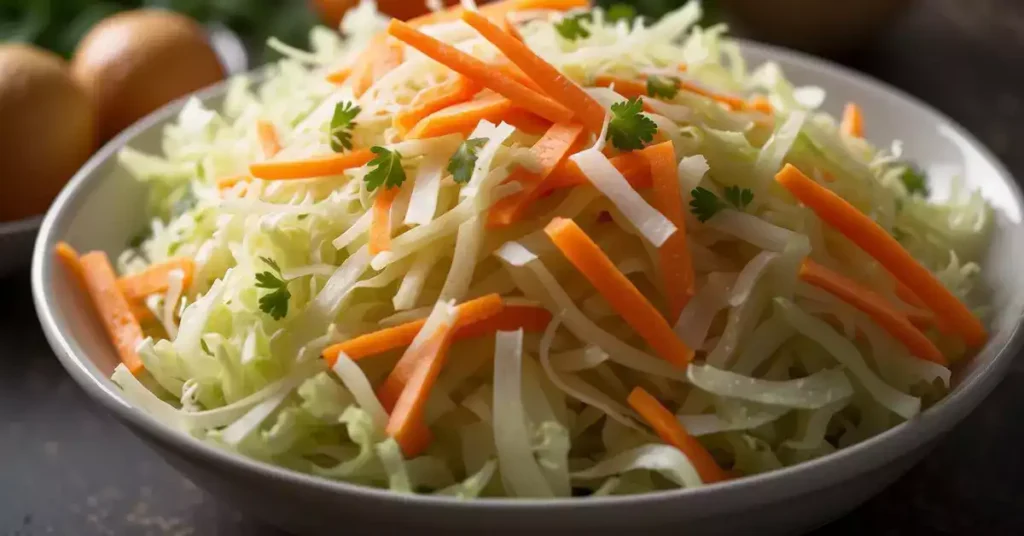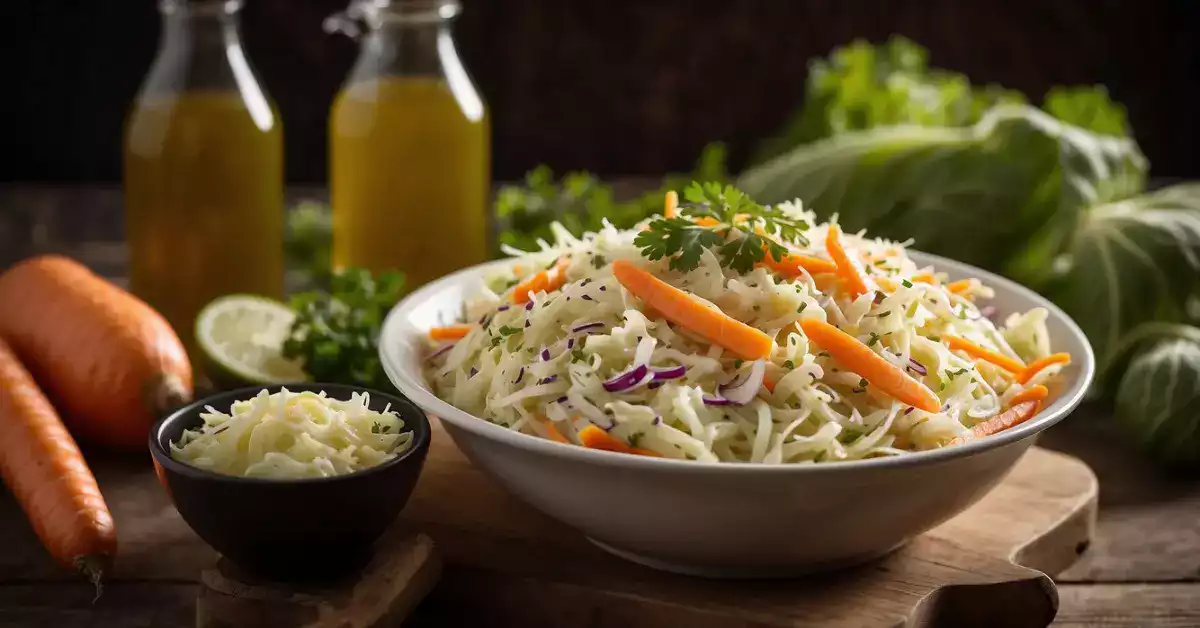Set off on a gastronomic adventure to the core of Europe with our guide to German Coleslaw! Pursue these simple instructions to whip up a tasty and effortless side dish that will bring a dose of genuine taste to any dining experience. We’ve compiled our top tips and wish you a wonderful time with this guide. Let’s get started.
Origin and Cultural Significance
When you explore German cuisine, you’ll find that krautsalat, the German take on coleslaw, is a traditional and beloved item. This German cabbage salad holds a special place on the dining table, complementing a variety of dishes with its crisp texture and tangy flavor.
Initially, the concept of shredded cabbage salad began in the Netherlands, but German coleslaw has evolved into a distinct variation revered in its own right. Known as krautsalat in Germany, it differs from the typical creamy American coleslaw, as it often uses a vinaigrette base instead.
The popularity of krautsalat is evident in its ubiquity at gatherings and its pairing with quintessential German dishes, such as sausages and schnitzels. You can often find it marinated with vinegar and oil, sometimes flavored with caraway seeds, which enhances its unique taste.
To give you an idea of how krautsalat fits into German cuisine, take a glance at this sample menu:
| Menu Item | Description |
|---|---|
| Schnitzel | Breaded pork cutlet |
| Bratwurst | German-style sausage |
| Krautsalat | Shredded cabbage salad with dressing |
| Kartoffelsalat | German potato salad |
This light and flavorful salad not only provides a refreshing counterbalance to the hearty, meat-centric dishes but also is deeply rooted in Germany’s culinary traditions, making it an essential experience for anyone savoring the variety and depth of German cuisine.
Preparation Tips and Variations

German coleslaw, or Krautsalat, is a delightful salad that offers various preparation methods and adaptations. With proper technique and fresh ingredients, you can create a dish that is both traditional and tailored to your taste.
Choosing Ingredients
For an authentic German coleslaw, start by selecting the right cabbage: white cabbage is traditional, but green cabbage works well, too. Incorporate grated carrots for sweetness and color, and add finely sliced onions, preferably yellow onions, for a bit of sharpness. If you like a hint of fruitiness, an apple can provide a nice balance.
Making the Dressing
The dressing for your coleslaw should be a flavorful mix of vinegar and oil. Options include olive oil, sunflower oil, or vegetable oil. Use apple cider vinegar, white wine vinegar, or cider vinegar for tanginess. Balance the acidity with a proper amount of sugar and salt, and consider adding mustard for complexity.
Assembling the Salad
Combine your shredded cabbage, carrots, and onions in a large bowl. Gradually pour the vinegar dressing over the mixture, ensuring the vegetables are well-coated. The secret to a fantastic texture is to let the salad marinate, allowing the flavors to meld together.
Authentic Variations
Authentic German coleslaw can include a variety of spices, such as caraway seeds, dill, parsley, or chives. For a Bavarian twist, try adding celery seeds or crispy bacon to the recipe.
Serving Suggestions
Serve your Krautsalat alongside traditional German dishes such as pork roast, potato dumplings, bread dumplings, or schnitzel. It’s also perfect as a companion to grilled meats and bratwurst or as part of a Brotzeit platter.
Storing and Shelf Life

Your coleslaw is best stored in the refrigerator, where it can last for several days. Always cover the salad to maintain freshness, and note that the flavor often improves after a day as the ingredients have more time to integrate.
Dietary Adaptations
To accommodate dietary restrictions, your German coleslaw can be adapted. For a vegan alternative, ensure all dressing ingredients are plant-based. To emulate American coleslaw, you may add mayo to the recipe for a creamier consistency.
Krautsalat Across the World
German coleslaw has many regional differences. For instance, Karottensalat is a carrot-centric version of the salad, and there’s a variation known as warm German coleslaw that is also popular in some areas.
| Ingredient | Authentic German Coleslaw (Krautsalat) | American Coleslaw |
|---|---|---|
| Cabbage | White cabbage | Green cabbage |
| Carrots | Optional, for sweetness | Commonly included |
| Onions | Yellow onions, thinly sliced | Often omitted |
| Apple | Optional, for added sweetness | Rarely included |
| Vinegar | Apple cider vinegar, white wine vinegar | Usually cider vinegar |
| Oil | Olive oil, vegetable oil | Often not used |
| Seasonings | Caraway seeds, mustard, dill, parsley | May include celery seeds |
| Mayo | Not traditionally used | A main component |
| Serving | Often served with robust meats & dumplings | Common as a light side or sandwich topper |
| Consistency | Crisper, less creamy | Creamier, due to mayo |
| Shelf Life | Can last in fridge for several days | Same, though may become soggy |
Nutritional Profile and Diet Considerations

When considering adding German coleslaw to your diet, it’s important to understand its nutritional components and how it can fit into your overall dietary goals.
Macro and Micronutrient Breakdown
German coleslaw, or Krautsalat, generally contains shredded cabbage dressed with a light vinaigrette. A typical serving size, which could be roughly one cup, might have the following nutrition facts:
- Calories: Approximately 150-200 calories
- Protein: 1-3 grams
- Carbohydrates: 10-20 grams, predominantly from sugars and fibers
- Fats: Low in saturated fat, with total fat ranging from 10-15 grams depending on the amount of oil added
- Sodium: Can vary, but homemade versions can be made with less sodium than store-bought varieties
- Cholesterol: Typically free from cholesterol as it’s a plant-based dish
- Fiber: Offers a good source of dietary fiber
The dish can also provide valuable micronutrients such as:
- Vitamin C: Found in cabbage, which supports immune health
- Iron: Essential for blood production, though the amount can be minimal
- Calcium: Important for bone health, present in smaller quantities
- Potassium: A vital mineral for heart function, present in cabbage
Health Benefits
Including German coleslaw in your diet can be beneficial due to its nutritional content.
- Low in Saturated Fat: A diet low in saturated fats can contribute to better heart health.
- Vitamins and Minerals: Vitamins such as Vitamin C and minerals like iron and potassium are essential for maintaining many bodily functions, from immune defense to muscle function.
- High in Fiber: The fiber content can aid in digestion and help you feel full longer, potentially aiding in weight management.
Remember, the exact nutritional content can vary depending on the recipe, particularly with the addition of ingredients like bacon or different dressings.
Always check the nutrition fact label or recipe to get the most accurate information for your dietary needs.
Here is a breakdown to help you see the nutritional profile at a glance:
| Nutrient | Per Serving (Approx.) |
|---|---|
| Calories | 150-200 |
| Protein | 1-3g |
| Fats | 10-15g |
| Saturated Fat | Low |
| Sodium | Variable |
| Cholesterol | 0mg |
| Carbohydrates | 10-20g |
| Fiber | High |
| Vitamin C | Present |
| Iron | Minimal |
| Calcium | Minimal |
| Potassium | Present |
The nutritious profile of German coleslaw makes it a fitting addition to your diet, whether you’re looking for a healthy side dish or a light, refreshing meal.
Consider the ingredients and preparation method to ensure it aligns with your dietary needs and preferences.
Our Opinion about German Coleslaw
German Coleslaw is a traditional side dish that is part of everyday life in many parts of Germany. This side salad is also very popular at larger celebrations such as the Oktoberfest or at a cozy barbecue evening. We like it best fresh and crunchy, but the ready-made versions in Germany are also consistently good to enjoy.
FAQ about German Coleslaw
What is German coleslaw?
German coleslaw, or “krautsalat,” is a traditional side dish made with shredded cabbage, vinegar, and oil, often flavored with caraway seeds or mustard.
Is German coleslaw healthy?
Yes, German coleslaw is a healthy option as it is low in calories and packed with vitamins and fiber from the cabbage.
What are some variations of German coleslaw?
Variations of German coleslaw include adding ingredients like apples, onions, or bacon for added flavor and texture.
Do you like German Coleslaw? Post your favorite Recipe in the comments below and inspire us all.






